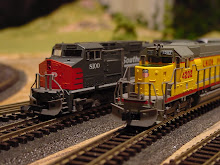In the track plan for the small layout, there is a curved bridge. After much research, I decided to use the common pile trestle kit from Blair-Line. This kit can be built straight or curved, and the price was reasonable.
The kit is very neatly packed, and the pieces are quite precise. I started with painting all the pieces with a dark brown acrylic prior to assembly as recommended.
The kit comes with various templates for building the bridge. Straight and about 8 various radii templates are available. I found that taping the template to the workbench and using double sided tape to attach the pieces to the template as you are gluing them together works very well. Below are a few pictures of the intermediate piles being built using the template.
These intermediate piles are quite finicky. The pieces are round, so they don’t want to stay where you want them. I used a scrapbooking adhesive tape to keep them in place while the glue dried. Something like this. After the glue dried, I slid a thin sheet of paper underneath the piles to remove them from the template paper.
Next was the end piles and end bents. The bents came pre-assembled, so all I had to do was to attach the piles to the bents. These were a lot easier than the intermediate piles.


Anyways, the following few pictures show the stringers being cut and put together.





Then I started gluing the intermediate piles in place. These I had to hold in place with a pair of tweezers for about 30 seconds to get the glue to set.
Last step: the end bents!
Voila! All done. Turned out pretty nice.
After taking some pictures, I turned it upside down and let the glue dry completely overnight. Well, it probably didn’t need to dry overnight, but I was pushing midnight on a weekday, so it dried overnight.
In the morning, I carefully measured how deep I needed to carve the opening on the layout. As I said above, I use code-80 Peco track. The track is on Woodland Scenics foam roadbed. As it turns out, I had to carve the underlying extruded foam exactly 2cm deep to have the rails line up correctly. This will obviously change based on what type of track you use. I essentially put the bridge upside down, took a piece of code-80 flex track and attached it to the bridge and laid down a piece of roadbed. Then I measured the distance from the bottom of the roadbed to the bottom of the end bent.
Here are a few pictures of the bridge in place on the layout.
I can’t wait to get the rest of the track laid and watch the trains roll over the trestle!



















Thanks for taking the time to write this excellent tutorial. I may have to find an excuse to use this on my layout! Very thorough and good pictures, too.
ReplyDeletenice article, love the look of the trestle.
ReplyDeleteThanks for the article. Much appreciated.
ReplyDelete